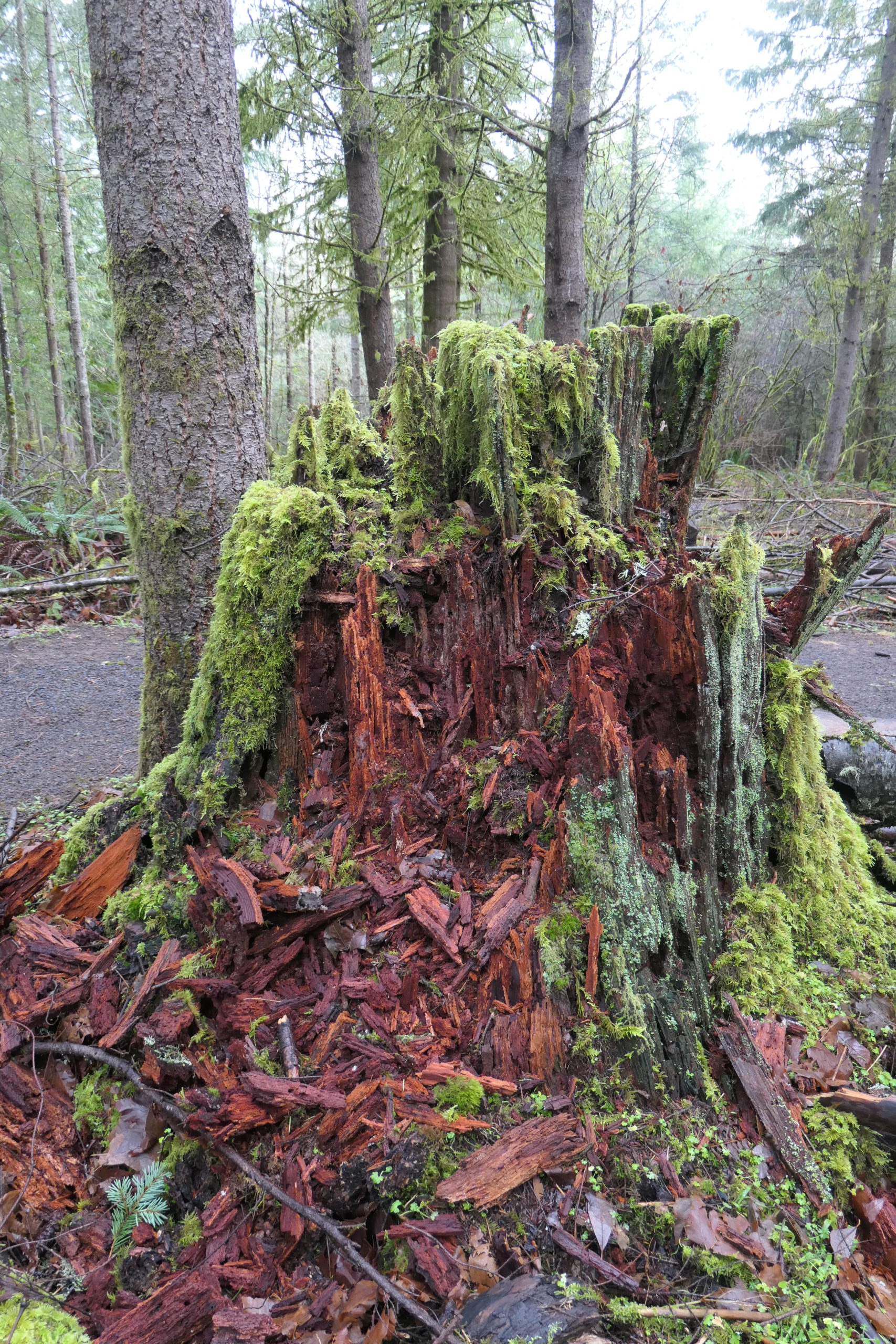None to be found, neither witches, nor butter. Hope defied, again!


Well, it was a trail name, referring to an orange-colored jelly-like fungus that is parasitic on fungi that inhabit decayed logs. (Tremella mesenterica.) That fungus did not make an appearance on my last hike either, but many other beautiful things did during my first excursion to Chehalem Ridge Nature Park.

The 1260 acres park opened a few months ago about 40 minutes southwest of Portland, near Cornelius. The land had been subject to housing developments before the market crashed. Then Metro stepped in in 2010 and purchased the land from a lumber company, with funds coming from the Trust for Public Land, the $6.1 million its largest acquisition. Since then smaller adjacent properties have been added.

Over the last 6 years the park was developed in earnest, by down-cutting the Stinson Lumber’s monoculture of fir trees where possible, planting native shrubbery and conifers, and giving remaining old growth of oaks, cedars and madrona trees room to breathe.

There is a 10+ mile system of trails, some wheelchair accessible, that is shared by hikers, horse riders and bikers in some places.


The parking lot has functional buildings and covered picnic areas, tons of space for kids to romp around. Pets are not allowed in the park, though, to protect sensitive wildlife.

Trails are clearly marked, and in the more crowded areas at the beginning there are plenty of benches so people can rest when needed.

Several view points offer stunning views of the coast range mountain and the Tualatin valley stretching out into the misty clouds.



Many of the trail names come from the Atfalati language, spoken by the Northern Kalapuyas, a tribe among the many that suffered a horrific fate when the colonialists arrived. With the settlers came the diseases. Malaria, transmitted by mosquitos, the potential vector Anopheles freeborni common in western Oregon until the early 1900s, was brought to Ft Vancouver by traders and spread from there. It reduced the tribal populations in the valley within three years, 1830 – 1833, by 80% (!), an apocalyptic loss. It hit the White settlers as well, but they knew to treat it with Quinine and had the remedy available, if in limited quantities.
“Cumulative evidence suggests that cultural unfamiliarity with the new diseases—that is, people did not know how to treat them—and the lack of effective medicines may have been as or more important than biological resistance, genetic or acquired, in accounting for the high mortalities. The loss of population resulted in abandoned and consolidated villages, the breakdown of social and political structures, and the loss of cumulated knowledge possessed by specialists (in a culture without written records), making the epidemics cultural as well as biological disasters.” (Ref.)

The Kalapuyans lived in tribal territories containing numbers of related and like-speaking, but basically autonomous villages. They were extremely versed in ecological management, treating the land for 4000 years with controlled, low intensity fires in the fall to create open oak savannahs and mixed forest growth.

This maximized the landscape for the products they needed most – seed, textiles, wapato, and forage for game.



——————————————————

In addition to the wood land trail, I hiked the short side trails of ammefu, which means ‘mountain’ in Atfalati, ayeekwa referring to bobcats,


and mampał, which means lake and could be a reference to Wapato lake, currently under restoration for a national wild life refuge after having been converted to onion fields by farmers.
Despite the January date, spring was in the air. It must have been the light green, bordering on chartreuse, everywhere. The forest floors covered with the invasive shining geranium,

the moss carpeting stumps, trunks and branches of the trees,





the first leaves of foxgloves, grass, lupines and even some fresh life among the Great Mullein.




The park also seems a magnet for piles. Piles from reforestation

piles from land management

piles from lunch

piles after lunch.

There is so much to appreciate in the land known as the Outside Place (Chehalem) by the Atfalati people. It speaks to the tenacity of life, even under hard conditions.


And if you are lucky you get to walk for a while behind goldilocks, who appreciated her Dad’s lesson on hibernation as much as I did. So much to learn, everywhere you turn. You just have to show up!

More vicarious walks for you all will be in the offing!
In the meantime here is an old Kalapuya prophecy, translated in 1945 by Melville Jacobs.
Long ago the people used to say that one great shaman in his dream had seen all the land black in his dream.
That is what he told the people. “this earth was all black (in my dream).”
He saw it in a dream at night. Just what was likely to be he did not know.
And then (later on) the rest of the people saw the whites plough up the ground
Now then they say, “that must have been what it was that the shaman saw long ago in his sleep.”

And here is a musical depiction of forest moods from a different continent….






Sara Lee Silberman
GLORIOUS photos, and such interesting stories [that, among other things, provoke outrage yet again that the native Americans lost their land to US!] so well told. Wonderful, though, that that lovely park now exists. More “vicarious walks,” PLEASE!!!!
Julie d moore
I was hiking there yesterday!!! I wonder if we were there at the same time???
I miss you and hope all is well!!!
May this new year bring us peace and delight


Martha Ullman West
A lovely, beautiful post, tender and charming, and yes a learning experience too. Thank you so much for the moss, the bobcat (not your photo I know) the scat! and Schumann’s music.